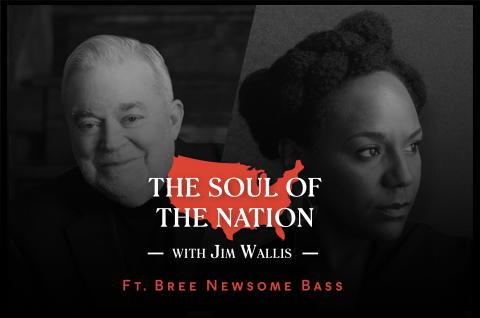Bree Newsome Bass on Removing Symbols of Hate
In this interview, recorded in 2020, Bree Newsome Bass speaks with Jim Wallis about the importance of removing symbols of hate and the need for a racial reckoning.
Bree Newsome Bass is an artist, activist, and public speaker. In 2015, she attracted international attention when she scaled a flag pole at South Carolina's Capitol Building to remove the Confederate battle flag in protest of systemic racism. The resulting publicity and overwhelming pressure led to the Confederate flag being permanently removed less than one month later.
In the interview, Newsome Bass describes the events surrounding her historic act of civil disobedience: "In 2015, by that point, we had been seeing a series of cases, particularly involving police brutality, being caught on video, unarmed black men being shot and killed by police. That was a lot of what was focused in the headlines, including in North Charleston, South Carolina, the case of Walter Scott. That happened in April of 2015. Then when we got to June of 2015, and we had this instance of a white supremacist driving from Columbia, South Carolina, down to Charleston, went into Emmanuel AME, this historically Black church with rich history dating back centuries, and murdered Black people during a prayer meeting. It was just so violent. There was a level of spiritual violence to it. I think that was part of the intention. It was an act of terror. It was meant to cause feelings of terror. Then once the images surfaced of Dylan Roof and you see him waving the Confederate flag. It naturally refocused attention on South Carolina's display of the Confederate flag at their capital, which had been controversial for years. My family's from South Carolina, so I grew up with the awareness of it. That flag was first raised in the '60s, really as a statement of opposition to the civil rights movement."
Newsome Bass came together with a group of other activists to make a statement, whith a particular emphsis on filming the event to bring national attention to injustice in the state. She emphasizes that this action was nonviolent "to draw a contrast with the violence that had occurred in Charleston. In Charleston, you had this person who went in in the evening, shot people who were unarmed and ran away. By contrast, I would be scaling this poll in broad daylight, just showing this defiance against that terrorism."
She continues, "Part of the reason why I did it so early in the morning was because there were all of these ongoing protests and counter protests down there at the site of the Confederate flag. We knew that there was a pro-Confederate flag rally planned for later that day. We were just trying to reduce the likelihood of somebody coming by with a gun, possibly. I knew I was going to be arrested. That I was really prepared for. But in addition to that, obviously, just the dangers of scaling a pole. The act itself was physically dangerous. But again, it's important to know as well, I had to scale the pole because of the way that South Carolina had designed the flag. You couldn't just walk up to it and lower it. That just became the method for how to get it down. But in doing that, it became a very powerful symbol for the ongoing struggle to dismantle the systems, the many people who have risked their lives, in some cases lost their lives in this ongoing struggle to dismantle these systems."
Newsome Bass was motivated by her faith to take action: "I did truly believe that I was called to do it and that God was going to bring me down safely. I likened it to the story of Shadrach, Meshach, and Abednego; I'm not going to bow down to this idol."
